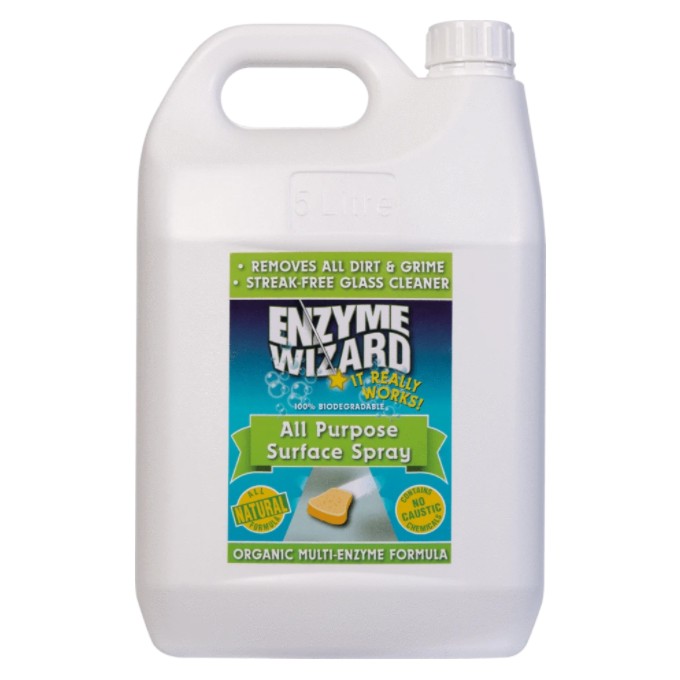Enzyme Wizard All Purpose Surface Spray safely cleans all surfaces around the Home & Office as well as general areas that need to be cleaned.
- Organic multi enzyme formula
- Breaks down the fats, oils and grease that bacteria feed on.
- Safe on any surface that can take water.
- Eliminates Foul Odours at the source.
- Gentle for Allergies, Asthma & skin irritations
- Suitable for all surfaces - Floors, walls, Glass, Stainless steel, Tiles, range hoods, BBQ’s, Bench tops.
- Powerful - does not push grease and dirt around with soap & water, but the enzymes work to destroy the mess.
Features / Benefits
- pH Neutral – No Palm Oil
- Soap Free Formula – Septic safe
- Contains no caustic ingredients – No Ammonia, No Chlorine
- General wiping down of surface is only required.
- Product does not contain soap and will not streak on any surface. No residue left behind.
- Can be disposed of down drains, enzyme will carry on breaking down organic matter in all sinks.
- Cleans: grease, dirt, wine, coffee, soda & juice stains, leaving no residue.
- Deodorises by destroying the organic matter causing odours, rather than just masking them.
- Assists the natural bacteria in septic tanks to break down material.
- Eliminates biofilm
How to Use:
- Dilute the product at a ratio of 10:1 into the spray bottle.
- For general cleaning wipe down surface preferably with a micro fiber cloth.
- In areas that have excess build up of grime, spray the surface with the general surface cleaner. Use a soft brush and scrub down the surface while at the same time leaving the surface wet with solution.
- In all areas can be used to wipe down all surfaces as normal.
- Mirrors – One to two sprays initially onto mirror and then wipe down with cloth (preferably micro fiber). When it comes to mirrors less is better.
Important Information
- For new surfaces use the dilution rates outlined on the packaging and follow general cleaning instructions
- For surfaces or areas that are badly soiled, mix a 1:1 solution and then scrub the surface with a soft brush, not a hard brush as the bristles won’t get into the grouting because it is lower than the surface of the tile.
- In hard to reach areas of a surface or anywhere in a general area, spray the surface cleaner onto the area and wipe down. The enzyme solution should soften and all that is needed should be to wash the area down with water.
- Do not mix the Surface spray with any bleach or oxidisers as this will de-activate the enzymes.
- It is also recommended that when starting to use the Surface Spray for general cleaning, use new micro fiber cloths and any other brushes or equipment you use, as there maybe residual soap and or scum on the cloths or on the brushes.
- In hard to reach areas ( under counters or equipment one can just spray the Surface spray into the area for a couple of days. When the organic matter softens wipe down with mop or cloth
Bacteria are smarter than you think.
All bacteria have automatic mechanisms by which they adhere to surfaces and to each other.
They form communities and secrete a protective layer of biofilm around them as a defensive measure.
Hidden behind this protective layer, they are able to feed and multiply.
Biofilm - What you need to Know
Biofilm is a collection of bacteria encased in extracellular polymeric substance (EPS), more commonly known as slime. This slime forms on surfaces and builds up over time, allowing pathogens to flourish and leading to contamination.
Many industrial companies struggle with biofilm. Build-up and subsequent contamination can occur on any type of surface, often including food production machinery, membrane filters, and pipes, to give just a few examples.
The slime is a problematic and unpredictable source of contamination that is very hard, if not impossible, to remove with traditional cleaning chemicals.
Although various methods are used to attempt to control biofilm, they are not without limitations. Aggressive chemicals such as caustic soda and bleach are often used, but they do not provide very good performance and, at the same time, corrode materials and machinery, endanger users, and negatively impact the environment.
Fortunately, a more efficient, safe, and environmentally friendly option is available – enzymes.
A two-step, Multi-enzyme method
Using an easy two-step cleaning procedure comprising a Multi-enzyme mix based on enzymes followed by a biocide step is an efficient way to rid surfaces of biofilm.
The enzymes act specifically on the EPS that forms the structure of the biofilm, degrading it and allowing the detergent to remove the biofilm. This enables the subsequent disinfectant step to reach all the way down to the exposed bacteria and
